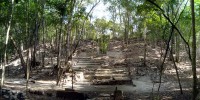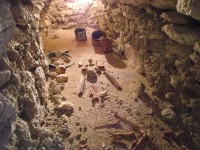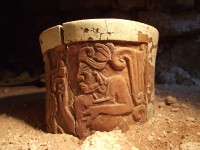 University of Bonn archaeologists have discovered the untouched tomb of a local prince in the royal palace complex at Uxul, a Maya site in the Mexican jungle near the border with Guatemala. Most of the 11 known buildings in the complex have been prey to looters looking for valuable ceramics and jewelry. Although there was a looting tunnel leading to this building (called K2) as well, the grave was discovered five feet under the floor and was untouched. It’s the first intact grave the team has discovered in four excavation seasons.
University of Bonn archaeologists have discovered the untouched tomb of a local prince in the royal palace complex at Uxul, a Maya site in the Mexican jungle near the border with Guatemala. Most of the 11 known buildings in the complex have been prey to looters looking for valuable ceramics and jewelry. Although there was a looting tunnel leading to this building (called K2) as well, the grave was discovered five feet under the floor and was untouched. It’s the first intact grave the team has discovered in four excavation seasons.
 The tomb is a single chamber with brick walls and a corbel vault. Inside archaeologists found the skeleton of a young man lying on his back with his arms folded over his stomach, five ceramic cups and four ceramic plates, some of them elaborately decorated with paintings and reliefs. One of the plates decorated in Mayan Codex-Style (a black outline drawing that uses the Mayan hieroglyphics seen in their surviving pre-Columbian books) was found on the young man’s skull. He was probably about 20-25 years old when he died, and one of the cups has an inscription bearing a date of 711 A.D. which is likely to be the year of his death, or at least near to it.
The tomb is a single chamber with brick walls and a corbel vault. Inside archaeologists found the skeleton of a young man lying on his back with his arms folded over his stomach, five ceramic cups and four ceramic plates, some of them elaborately decorated with paintings and reliefs. One of the plates decorated in Mayan Codex-Style (a black outline drawing that uses the Mayan hieroglyphics seen in their surviving pre-Columbian books) was found on the young man’s skull. He was probably about 20-25 years old when he died, and one of the cups has an inscription bearing a date of 711 A.D. which is likely to be the year of his death, or at least near to it.
 That vessel also bears an inscription labeling it as “the drinking vessel of the young man/prince.” Since he was found in the largest building yet discovered in Uxul’s royal palace complex, archaeologists feel secure in pronouncing him the latter since a non-royal “young man” would not get such prime funerary real estate. The absence of jade jewelry marks him as a minor prince, not directly in line for the throne.
That vessel also bears an inscription labeling it as “the drinking vessel of the young man/prince.” Since he was found in the largest building yet discovered in Uxul’s royal palace complex, archaeologists feel secure in pronouncing him the latter since a non-royal “young man” would not get such prime funerary real estate. The absence of jade jewelry marks him as a minor prince, not directly in line for the throne.
Scientists believe that Uxul, originally a smaller independent kingdom, was inhabited and ruled from time to time by the leaders of the ruling Kaan Dynasty in Calakmul. But the influence subsided after 705 AD, and there is a strong likelihood that a local ruling family came to power for a few generations. At the start of the 9th century, Uxul was almost completely deserted.
The Uxul palace complex was completed around 650 A.D. when the Kaan (Kaaaaaan!) dynasty had been in control for two decades. Relief panels found last year in the same building where the grave was discovered depict four of the Kaan kings playing the ballgame. The local royal family that took over after the Calakmul dynasty lost power probably still had some dynastic links to the previous rulers.
The city of Uxul was an important trade hub between the two major Mayan urban centers of El Mirador to the south and Calakmul to the northeast. It had trade links south into Guatemala and north to the Central Mexican Plateau, hence its appeal to its powerful neighbor.
Located deep in the Calakmul Biosphere Reserve, Uxul is difficult to reach. The sole access is 75 miles of jungle paths, and archaeologists can only dig for two to three months during the dry season. Undaunted, the archaeological team hopes to find more unlooted graves in the K2 palace building that will provide valuable information about the shifting power dynamics of the late Calakmul period.